Book reviews
 |
 |
 |
 |
 |
 |
 |
The Decisive Battle of Czestochowa
& the Epopee of Jan Sobieski
Book reviews of The Deluge and Pan Michael
by Henryk Sienkiewicz, Little, Brown & Co., 1887 - Vols. 2 & 3 of The Trilogy
by Henryk Sienkiewicz, Little, Brown & Co., 1887 - Vols. 2 & 3 of The Trilogy

Read the review of Volume I here
To make matters worse, Swedish forces led by their King Charles Gustavus invaded Poland from the north and west, as Sweden had a large standing army due to the recent 30 Years War and saw an opportunity to strike Poland, which was weakened by its recent struggles with the Cossack rebellion.
The debilitated and demoralized Polish nobility quickly surrendered to the Swedes who then occupied Warsaw and Krakow. The Polish King John Casimir fled to Silesia. There began a resistance to the Swedes led by a few nobles and many peasants engaging is a kind of guerrilla warfare.
This story is told through the characters of Andrej Kmita and Aleksandra Billevich, betrothed to one another by their fathers. The arranged marriage was one that ended in real love, but Kmita was unruly and surrounded by bad companions, displeasing Alexandra who encouraged his change of life.
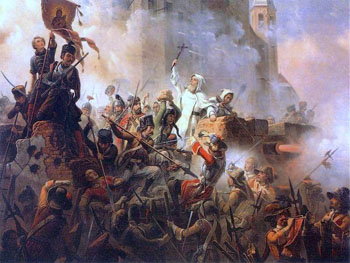
Fr. Kordetski is a hero of the Battle of Jasna Gora
He and his small band made their way to the Monastery of Jasna Gora where he warned the Prior, Fr. Kordetski, of the plot by the Swedes to grant amnesty to the Polish at Czestochowa and then to loot the Monastery.
The story of Czestochowa told by Sienkiewiez is largely accurate historically. lt was really the courage of Fr. Kordetski that kept the resistance alive and brought about the defeat of the Swedes at Jasna Gora. The role Kmita played in the battle won him the trust and honor that he had lost.
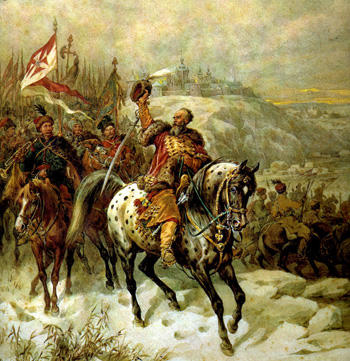
The valor and loyalty of Stefan Czarniecki made him a national hero
Many of the main characters were historical figures: King John Casimir, the Radziwills, Jerzy Labomirski, Jan Sapieha and Stefan Czarniecki. Stefan Czarniecki rose from a petty nobleman to become the Crown Field Hetman, the leader of the entire Polish Army.
Czarniecki was an exceptional figure in this work. His continued and unwavering support of the King was instrumental in the defeat of the Swedish Deluge and made him a national hero; his name is even mentioned in the Polish national anthem. He developed a guerrilla type of warfare with hit and run tactics that were very effective against the Swedes.
Pan Michael: Romance & Battles
The third book that completes Sienkiewicz' saga is Pan Michael, published in 1888. It tells the story of Colonel Volodyovski, a fictional character based on a real person, Colonel Jerzy Volodyovski, who was a captain under Hetman Jan Sobieski. The story takes place from 1668 to 1673, during a war between the Polish-Lithuanian Commonwealth and the Ottoman Empire.
Pan Michael is a faithful soldier and an unsurpassed swordsman who always put duty before his personal desires, delaying his marriage several years to fight in the Ukraine. He finally married Barbara (Basia) Jeziorkowska, who accompanies him to Hreytyoff near Moldavia. This romance appears principally in the first part of the novel, but in the second half the fighting against the Turks takes over.
Pan Michael is ordered by Jan Sobieski to defend the Polish fortress Kamianets with 1,500 men. They were besieged by 150,000 soldiers of the Ottoman Turks. The battle occurred on August 18-27, 1672, and in it Pan Michael is killed by a Turkish mine.
The last scene is in the Church of St. Stanislaus in Kamianet for the funeral of Colonel Volodyovski. The priest concludes with a prayer asking Almighty God not to abandon them but have pity on them and send them a man who would defeat the impious Mohammadans and fill Polish hearts with new valor.
At that moment the rear door of the Church opens and Capitan General Jan Sobieski enters. He kneels at the coffin and prays for the soul of Volodyovski, the first soldier of the realm. This moving scene reflects well the epic spirit of the Trilogy.
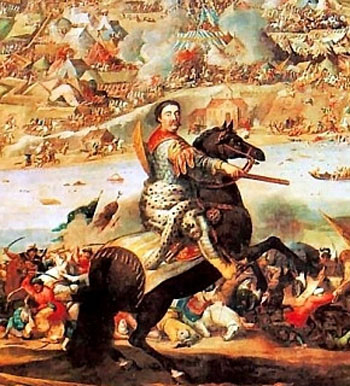
Sobieski, victorious at Hotin & later crowned King
The Turkish leader Hussein Pasha did not want to meet Sobieski in an open battle. According to Sienkiewicz the Poles had 31,000 men and 50 cannons while the Turks were three times superior in numbers of men with 120 cannons. The Janissaries, their best soldiers who were kidnapped Christian children raised as Moslems, alone were said to number 18,000.
On the second day the Turks decided to give open battle. The forces of Sobieski entered the attack, but he strategically held back his legendary Hussars, the heavy cavalry that were the best in Europe, for the final central assault. There were 15 regiments of Hussars under the Ruthene voivode (leader) Jablonovski waiting for the attack. The Hussars charged up the center crushing the 18,000 Janissaries. Interestingly, as part of their uniform, the Hussars wore feathered wings on their backs, which had the effect of frigthtening the enemy.
At the end of the battle, a Te Deum was sung and the Grand Marshall Sobieski heard the Mass and the Te Deum, according to Sienkiewicz, prostrate on the ground with his arms in the form of a cross.
When he arose, tears of happiness slipped from his noble countenance. Upon seeing this the multitude of soldiers, still stained with blood and trembling after the force of the battle, cried powerfully three times: ”Vivet Johannes Victor:"
The Polish King, Michael Visnovieski, the son of Prince Jeremy Visnovieski, had died the day before the Battle of Khotyn. Jan Sobieski and the nobles returned to Warsaw for the election of a new king. That king was Jan Sobieski himself.
The Epilogue continues: "And 10 years later, when King Jan Sobieski reduced to ashes the power of the Turks in Vienna, this cry resounded from sea to sea, from mountain to mountain, through the entire world, in whatever place where the bells called people to prayer." (p. 527)
Conclusion
I read the trilogy initially in English and then, more recently, read it in Spanish. In the Introduction of Fire and Sword, Prof. Marcin Kazmierczak, writing in Spanish, reached the same conclusion as I did: That Poland had many similarities to Spain, although expressed in a much more brilliant way.
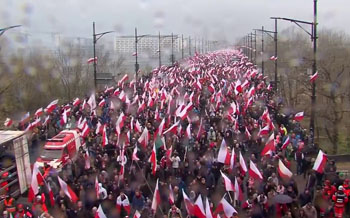
The Poles above, protesting the Muslim immigration; below, a turnout for a rosary crusade on its border
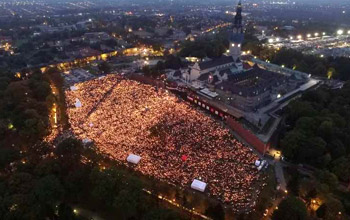
He noted a surprising number of similarities: Both countries rose up in the Middle Ages and until the beginning of the modern era were bastions of Christianity or Western Civilization – essentially synonymous. Both were fighting against the Turks: Spain at Lepanto and Poland in Bulgaria and the Ukraine. Both countries called the 16th century a golden century. Prof. Kazmierczak did not mention the Reconquest of Spain, the 771-year-war of Spain against the Moors, or the Polish victory at the Battle of Vienna in 1683.
At the time Sienkiewicz wrote the Trilogy in the 19th century, Poland did not exist as a State, but for 100 years had been under the occupation of the three adjacent empires: Russia, Prussia, and Austria-Hungary.
The Polish themselves, including scholars, view the Trilogy of Sinkiewicz as a Polish epic.
At present I can see Poland and parts of Eastern Europe beginning to rise like a phoenix: vast pilgrimages, Rosary crusades and the rejection of the European Union. I have great respect for the Polish people and have hopes that God will raise them again as a bastion of Western Civilization and the Holy Roman Catholic and Apostolic Church.
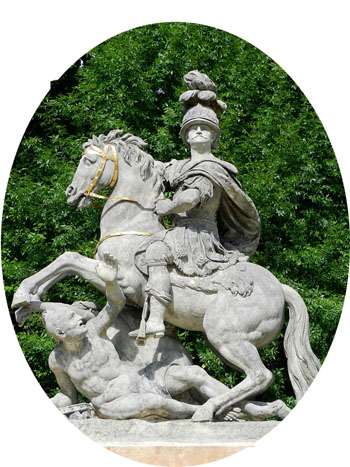
Statue of Jan Sobieski vanquishing a Muslim,
honored in Warsaw square
Posted November 6, 2019
______________________
______________________
 Volume I |
 Volume II |
 Volume III |
 Volume IV |
 Volume V |
 Volume VI |
 Volume VII |
 Volume VIII |
 Volume IX |
 Volume X |
 Volume XI |
 Special Edition |